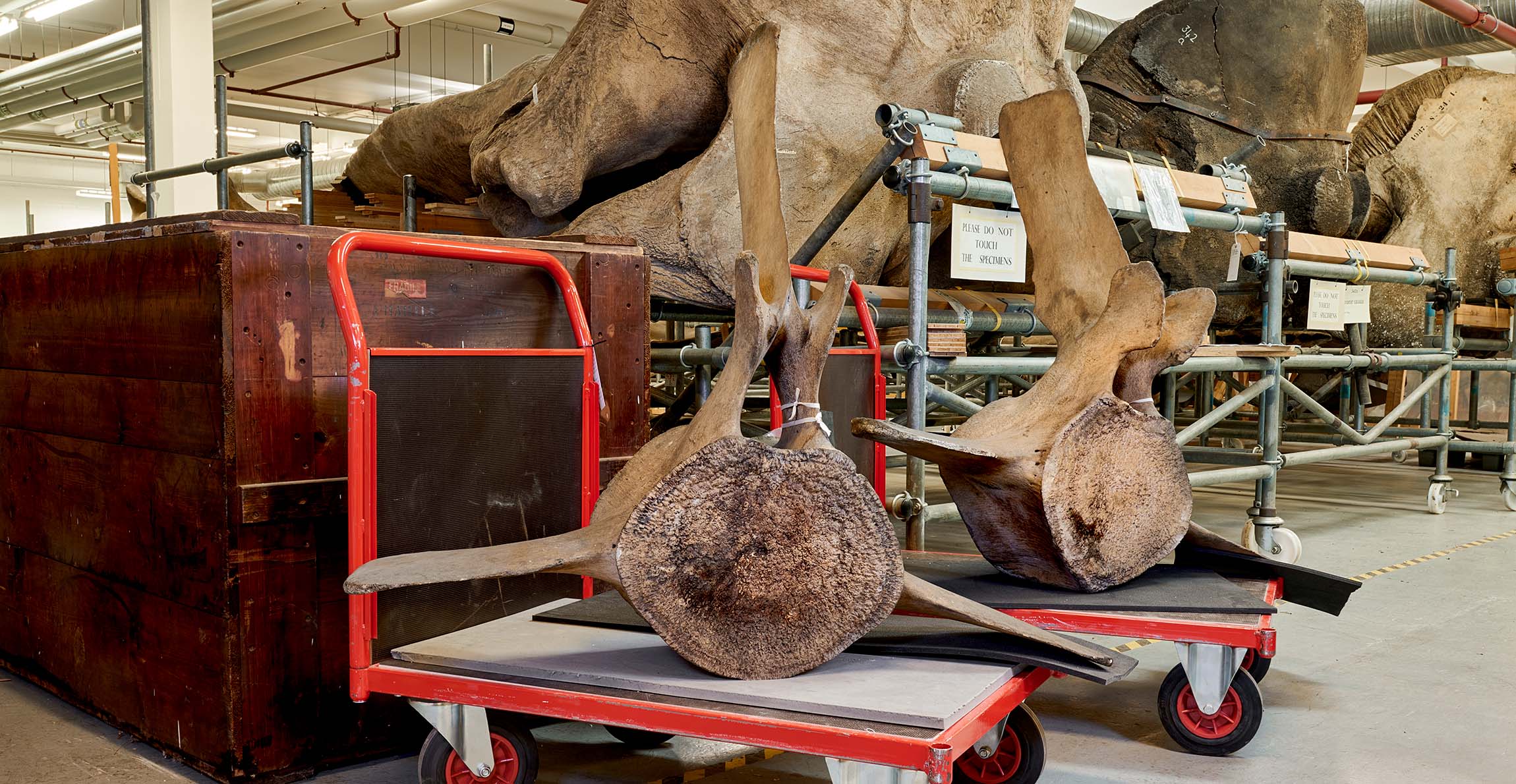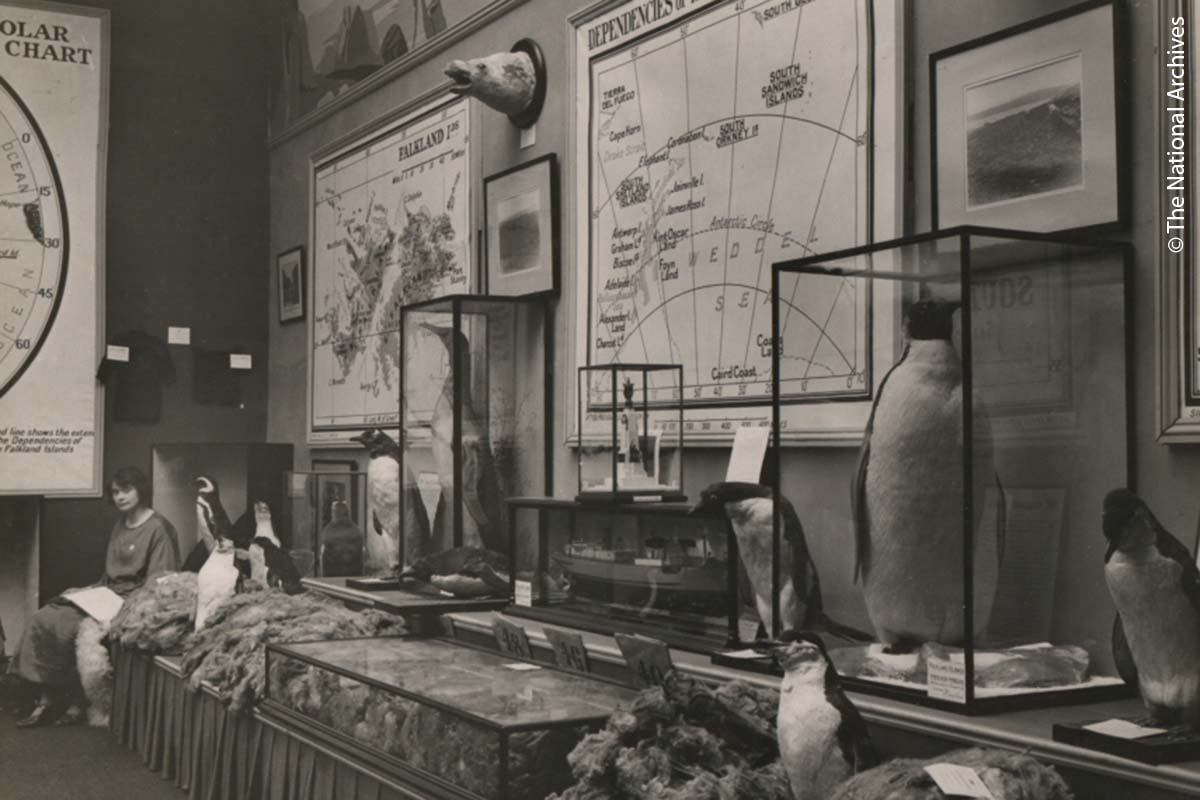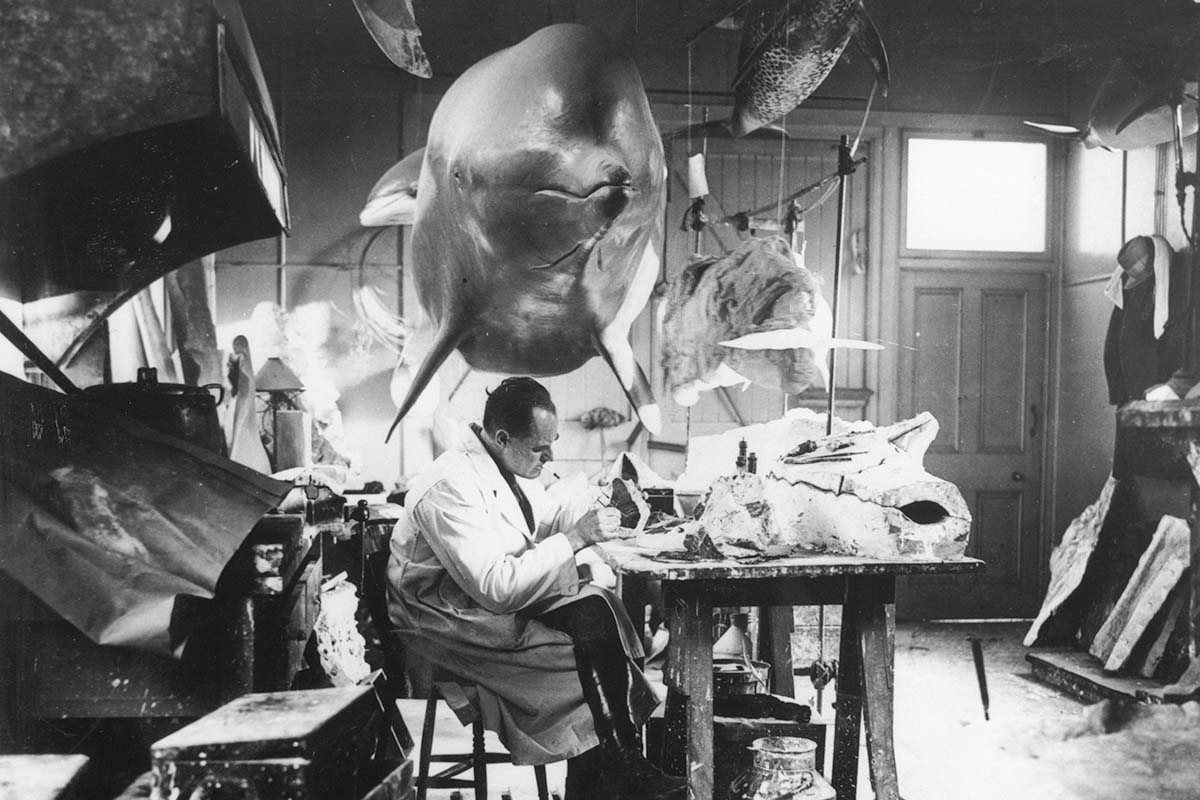
Having been given to the Natural History Museum over a century ago, the past of these whale vertebrae is only now being rediscovered.
© The Trustees of the Natural History Museum, London
Whales in Wembley: Origins of mysterious blue whale bones uncovered
Sophia Nicolov and James Ashworth
First published 6 November 2024
A mystery beginning in the South Atlantic and ending in South Kensington has finally been solved.
The century-long story of two blue whale vertebrae can now be told for the first time, revealing their part in helping to ban whaling.
In the final resting place of some of the largest animals on Earth, countless secrets remain to be told.
The cetacean collection at the Natural History Museum is a treasure trove of remains from whales, dolphins and their relatives. The bones, skins and baleen it houses span hundreds of years of history, providing an ever-growing record of humanity’s relationship with these marine mammals.
Containing over 6,000 specimens, the cetacean collection is one of the most important of its kind and has been intensively studied by scientists from all over the world. This means there is extensive data for most objects – barring one or two surprises.
When Dr Sophia Nicolov came across a pair of discoloured labels attached to two huge blue whale vertebrae in the collections, her curiosity was piqued. Sophia is an Early Career Research Fellow who has been working to better understand the history of our specimens.
She had no idea the bones would be the beginning of an investigation spanning over 100 years and half the world. Or that it would unravel a long-forgotten link between the Natural History Museum and a colonial exhibition showcasing wildlife from across the British Empire.

References to the "Wembley Exhibition" initially mystified researchers.
© The Trustees of the Natural History Museum, London

The British Empire Exhibition was held in 1924 and 1925.
Image © David Rumsey Map Collection, David Rumsey Map Center, Stanford Libraries, licensed under CC BY-NC-SA 3.0 via davidrumsey.com
Uncovering the British Empire Exhibition
At first, the labels seemed quite straightforward. The handwritten notes contained the scientific name of the blue whale, Balaenoptera musculus, followed by a date and location: Nov 6th 1924, Falkland Islands.
But there was one other piece of information that captured Sophia’s attention. The labels referred to something called the ‘Wembley Exhibition’. Neither Sophia nor her colleague Richard Sabin, the Natural History Museum’s Principal Mammals Curator, had heard of this exhibition.
Research quickly revealed that this referred to a historic event called the ‘British Empire Exhibition’. While it may not be well-known today, more than 27 million people visited it in 1924 and 1925 – making it one of the largest events ever held.
Its main purpose was to project a powerful and unified image of the British Empire at a time when its influence was starting to falter. Grand pavilions were constructed around Wembley Park, London, showing off the material resources and industries of the 56 different dominions, colonies and protectorates they represented.
“When I started looking into the Exhibition’s history, I couldn’t believe the scale of it,” Sophia recalls, “Despite the enormity of it, both Richard and I were surprised by how relatively unknown the British Empire Exhibition appears to be.”
“Its links to the Natural History Museum, then a part of the British Museum, are particularly obscure. There doesn’t seem to be much contemporary knowledge about that, so I was determined to find out more – these [blue whale] vertebrae didn’t just appear out of a vacuum.”

The British Empire Exhibition's pavilions highlighted a variety of aspects about the territory they represented, including the animals which lived there.
© The National Archives, used under license

The Southern Whaling and Sealing Company, owned by Lever Bros, displayed a variety of whaling implements in the pavilion.
© The National Archives, used under license
Cetaceans and colonialism
To find out more about the whale bones, Sophia had to uncover more about what was on display within the British Empire Exhibition’s regional pavilions. Their contents varied hugely, from bizarre sculptures made entirely from butter to the racist and deeply problematic ‘Races in Residence’ where hundreds of colonial subjects were brought to London to form part of living displays.
Since their closure, records of the pavilions were dispersed across a variety of archives. Sophia delved into them as part of her research, and was able to locate a series of photographs of the Falkland Islands Pavilion in the UK’s National Archives.
As well as the islands themselves, this pavilion represented what were then known as the Falkland Island Dependencies, which included South Georgia and the South Shetlands. As this region’s largest industry, the pavilion focused heavily on whaling.
At this time, hunting whales was big business. The animals were a valuable source of oils for lubricating machines, making soaps, margarine and other products that fuelled the growth of the British Empire.
One of the major whaling firms was the Southern Whaling and Sealing Company, which exhibited many of its tools of the trade in the Falkland Islands Pavilion. The latest in harpoon guns, knives and hooks were on display, as well as photos of how they were used.
The Falkland Islands Pavilion also highlighted the diverse array of wildlife found in the Southern Oceans which were ripe for exploitation. This included a variety of whale remains, and while many can be seen in the archival photos, the two whale vertebrae aren’t among them.

While the location for the whale bones was given as the Falkland Islands, this could refer to a variety of places in the South Atlantic and Southern Ocean.
Public domain image from the Challenger Collection, from the library and archives of the Natural History Museum, London
Fortunately, Sophia’s research in the Natural History Museum’s own archives was able to confirm they were at the exhibition. She found letters showing that the bones were collected from the pavilion by one of the museum’s taxidermists, Percy Stammwitz, on 5 November 1924.
While this established that the vertebrae were indeed from the South Atlantic, it still didn’t reveal exactly where these bones came from. The ocean surrounding the Falkland Islands, South Georgia and the South Shetlands is vast, and the specimens could have come from anywhere within it.
“Accurate spatial and temporal data are crucial for museum specimens,” Richard explains. “Without this data, it’s much harder to make use of them for scientific research.”

By finding out where they originally came from, Sophia's research makes the vertebrae more useful for scientific research.
© The Trustees of the Natural History Museum, London
Following the paper trail
The key to solving this mystery was found in a dense box of letters found elsewhere in the archives. They belonged to Sir Sidney Harmer, the Director of what is now the Natural History Museum between 1919 and 1927.
In a letter to a Mr A. Radcliffe, the manager of the Southern Whaling and Sealing Company, Harmer expressed his thanks for the whale vertebrae from the Falkland Islands Pavilion. It revealed that the bones came from either one or two whales killed off South Georgia, which were taken back to the island for processing.
Further details were found in a memo sent by Harmer, which showed that the vertebrae had been left on a beach in South Georgia for over a year before being collected and shipped to London for the exhibition.
This made them particularly useful for Harmer who had been investigating the impact of whaling around South Georgia for more than a decade. Whale populations had declined dramatically in the region, and Harmer was an early voice calling for much needed regulations on the whaling industry.
Although Harmer would later use the vertebrae as part of a long-forgotten talk at the Zoological Society of London, little is known of their use in research over the following century.
Sophia and Richard hope that with the enhanced locality data the vertebrae can now be used more regularly by scientists investigating the impacts of whaling. They also plan to make a 3D scan of the vertebrae to ensure these bones can be accessed by researchers from all over the world.
While Sophia might be one step closer to resolving the mystery of these vertebrae, her research has revealed that they were only a small part of a wider relationship between the British Empire Exhibition and the Natural History Museum.

To prepare the best possible cast, taxidermists like Percy Stammwitz (pictured) had to work on new specimens as soon as they arrived.
Public domain image from the library and archives of the Natural History Museum, London

Percy Stammwitz produced many of the whale and dolphin casts on show in the Natural History Museum today.
Public domain image from the library and archives of the Natural History Museum, London
The legacy of empire
One object which nicely highlights these links between is a paper cast of a Commerson’s dolphin on display in the Falkland Islands Pavilion. It can be seen suspended above the heads of visitors as they wandered around the displays.
It was based on a dolphin which had been killed near the Falkland Islands in 1922, and then sent packed in salt to the Natural History Museum. A plaster cast was made as soon as it arrived, which was later used to make the paper cast for the exhibition.
While the whereabouts of the paper cast are now unknown, Sophia found the original cast and skeleton in the collections. Other remnants of the Falkland Islands Pavilion in the collections include several seal and penguin specimens that were prepared by Stammwitz for display.

The Commerson's dolphin cast seen hanging from the roof was based on a specimen still held in our collections.
© The National Archives, used under license

Taxidermy on display in the Falkland Islands Pavilion included specimens prepared by Percy Stammwitz.
© The National Archives, used under license
Other pavilions are also represented among the Natural History Museum’s collections, with Sophia able to identify a number of other specimens acquired from the exhibition. These include a specimen of the antelope-like Sumatran serow from Malaysia, as well as an example of the smallest living flightless bird, the Inaccessible Island rail.
This has spurred researchers to now investigate what other links exist between the collections and the British Empire Exhibition, searching for more connections to this mostly forgotten event.
“The specimens from the exhibition highlight the complex ways the British Empire weaves through the collections, and the impact our imperial past had on the natural world,” explains Sophia.
“This underscores the complicated, changing and accumulating significance of natural history specimens, the enduring legacy of the Natural History Museum’s role in cetacean science, and the necessity of engaging with questions around empire in our collection.”
Sophia continues to explore these questions as part of a project to investigate the links between cetaceans, colonialism and commerce, with many more important histories yet to be told.




Don't miss a thing
Receive email updates about our news, science, exhibitions, events, products, services and fundraising activities. We may occasionally include third-party content from our corporate partners and other museums. We will not share your personal details with these third parties. You must be over the age of 13. Privacy notice.
Follow us on social media